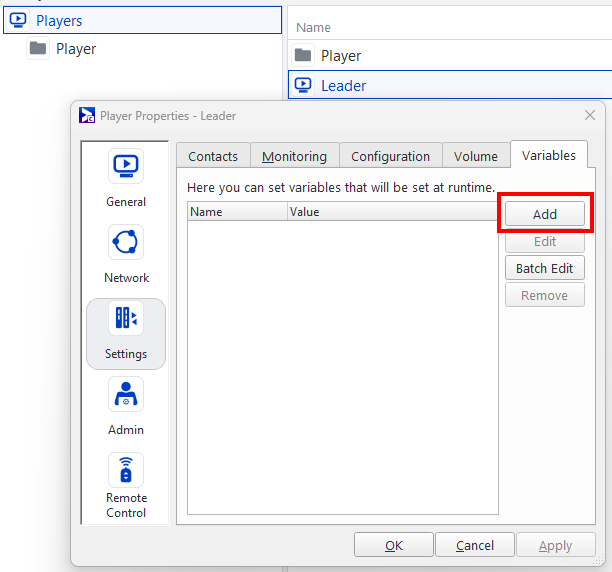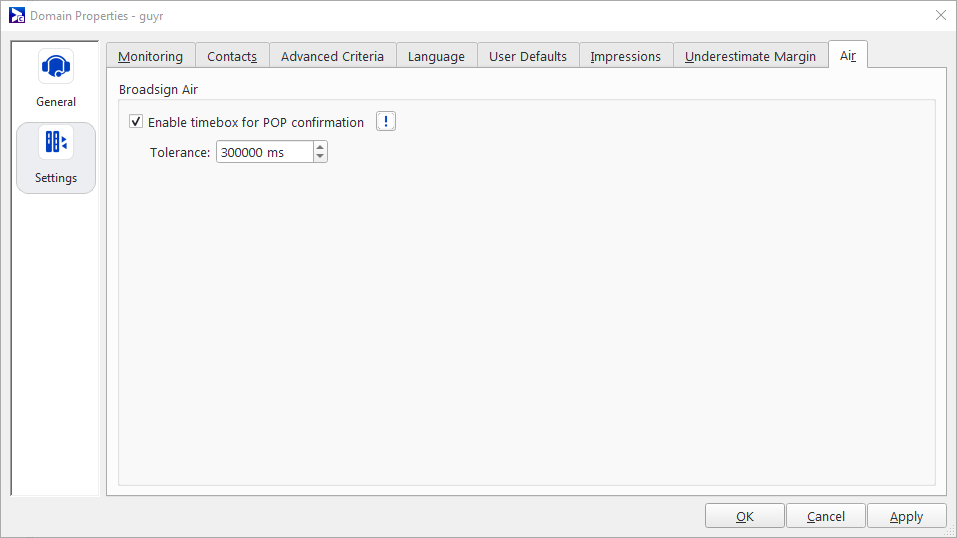Third-party players often request playlists at irregular intervals, making it their responsibility to report POPs (proof-of-play). This presents a challenge when multiple third-party players in a single venue are represented by a single player registration in Broadsign Control, especially when aiming for synchronized playlists and accurate POP reporting via Broadsign Air.
One-to-One Relationship (Simple Scenario):
- When a single Broadsign Air player corresponds to a single Broadsign Control "player" registration, each confirmed playback directly translates to one POP.
Multiple Players, Single Registration (Complex Scenario):
- In venues with multiple third-party players linked to a single Broadsign Control registration, Broadsign Air aggregates individual playback confirmations server-side.
- This aggregation leverages the optional
screen_identifierssubmitted with each confirmation to track which specific screens have played the content. - Once a defined threshold of confirmations is reached (indicating enough players have played the content), Broadsign Air issues a single POP for the Broadsign Control player, incorporating the screen multiplier to reflect the multiple screens involved.
Example: Venue with 20 Players
- Each of the 20 players independently reports its playback in near real-time.
- Aggregation is server-side, with POP submission as soon as the threshold is exceeded.
- A venue is modeled in Broadsign Control as a single player with multiple monitors (player.nscreens).
- Each physical player must have a unique
screen_identifierwithin the sameplayer_identifierfor accurate POP tracking.
- The system uses a threshold (for example, 80% of expected players) to determine when a POP is confirmed. (See Configure the POP Threshold for customization details).
- Broadsign Air uses the
screen_identifiers to properly count playback confirmations until the POP threshold is reached.
- Broadsign Air uses the
- Once the threshold is met (16 out of 20 players confirm playback), Broadsign Air submits a POP for the associated Broadsign Control player.
In scenarios where some screens might be offline or experience network issues, you can configure the POP threshold so that Broadsign Air generates a POP even if not all third-party players have confirmed playback.
To configure the POP threshold:
- Open Broadsign Control Administrator.
- Go to: Player Properties -> Settings -> Variables.
- Add a Player Variable named max_pop_not_confirmed.
- Set its value to the number of screens you'll allow to be missing before a POP is reported.
For more information on Player Variables, see Settings Section - The Variables Tab.
The system calculates the minimum number of required check-ins (required_checkins) as follows:
required_checkins = screen_count - max_pop_not_confirmed- This value cannot be less than 1, ensuring at least one player must check in.
Once the number of confirmed playbacks reaches the required_checkins threshold, Broadsign Air will report a POP for all the players associated with that Broadsign Control player registration.
Examples:
- Scenario 1 – 20 screens, max_pop_not_confirmed = 2
- A POP will be reported as soon as 18 screens have checked in.
- Scenario 2 – 5 screens, max_pop_not_confirmed = 2
- A POP will be reported after 3 check-ins.
- Scenario 3 – max_pop_not_confirmed is not set (or is 0)
- All screens must check in before a POP is reported.
Note: This feature requires Broadsign Control Administrator v14.3 or later.
The standard threshold mechanism for issuing POPs, while effective in most cases, can be problematic when multi-screen Broadsign Air players share screens with external playback systems. These external systems might interrupt individual screens at unpredictable times and for varying durations, making it difficult to set a single threshold that accurately reflects true playback across all screens.
For example, at any given time in a 24-screen deployment, it may be 5, 10, or all 24 screens that are interrupted. Under these circumstances, it is impossible to find a “best fit” threshold level that reasonably accommodates all varieties of interruption.
Timebox for POP Confirmation
The Timebox for POP Confirmation value can be used to report POPs based on the exact number of screens that have actually confirmed playback.
Using this value, Broadsign Air will accept POPs until the timebox (start time + duration + tolerance for POP confirmation) is elapsed.
For example, if content was scheduled to play at 10:00 am for 1 minute, and the timebox for POP confirmation tolerance is 5 minutes, then the last playback confirmation accepted would be at 10:06 am.
Once the timebox for POP confirmation is exceeded, Broadsign Air reports the POP with the number of screens that have actually confirmed playback (nscreens).
For example, if 20 third-party Broadsign Air players are using the same playlist, and 16 have confirmed playback by the the time the timebox has elapsed, then Broadsign Control Administrator reports a POP of 1 with an nscreens value of 16.
The deadline for POP confirmation interacts with the threshold (max_pop_not_confirmed) value as follows:
- When no threshold is set, Broadsign Air produces the POP for the actual number of players that have confirmed playback when the timebox for POP confirmation expires.
- When a threshold is set, Broadsign Air produces the POP for the actual number of players that have confirmed playback, if the threshold is satisfied when the timebox for POP confirmation expires.
To set the timebox for POP confirmation tolerance value:
- Open Broadsign Control Administrator.
- Go to: Domain Properties Menu > Edit Domain.
- Click the Settings section, then the Air tab.
- Check Enable timebox for POP confirmation, then enter a value in milliseconds.
- Click OK.
This indicates the period over which confirmed playbacks will contribute to the POP. The default value is 300,000 ms (5 minutes).



